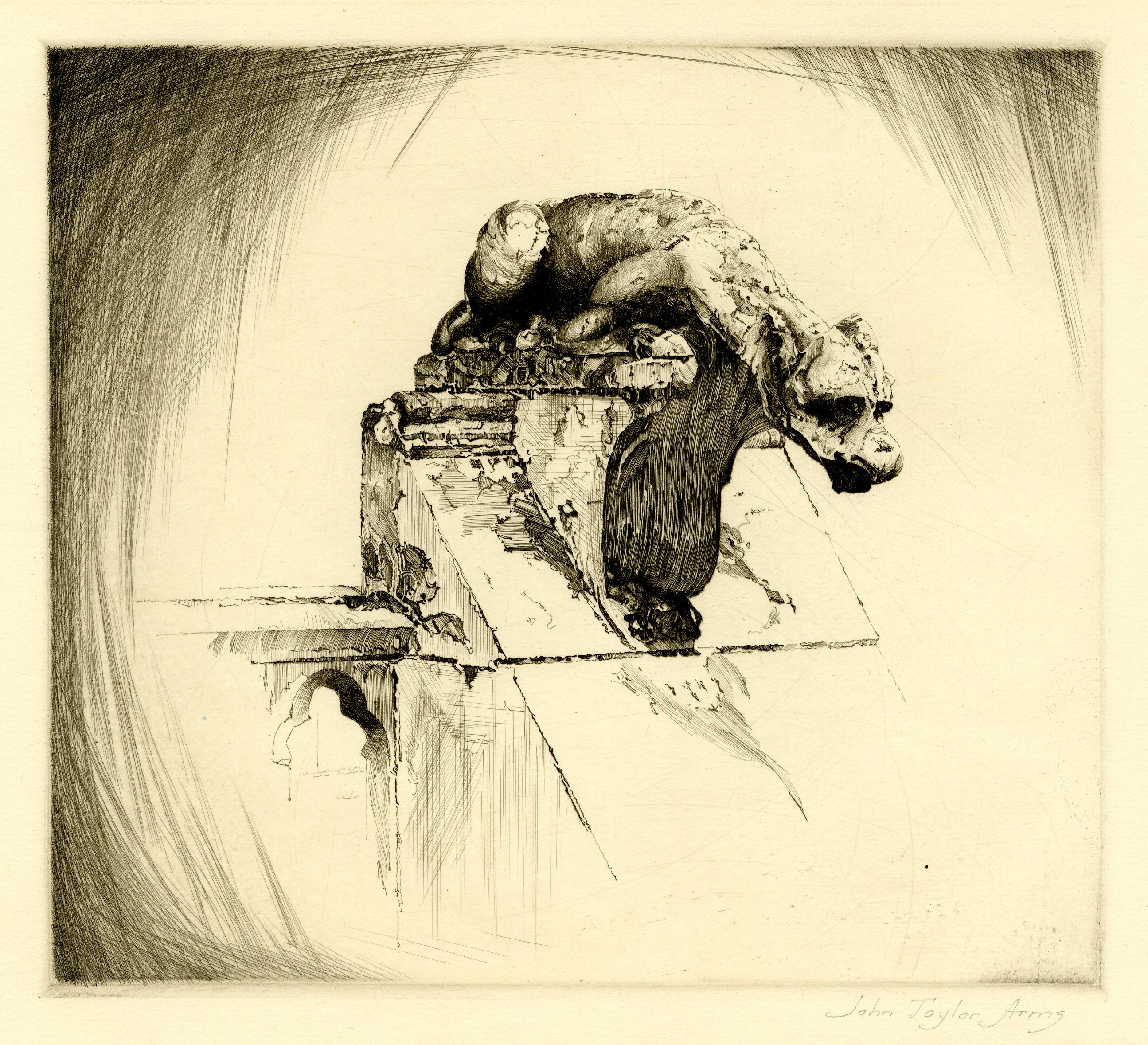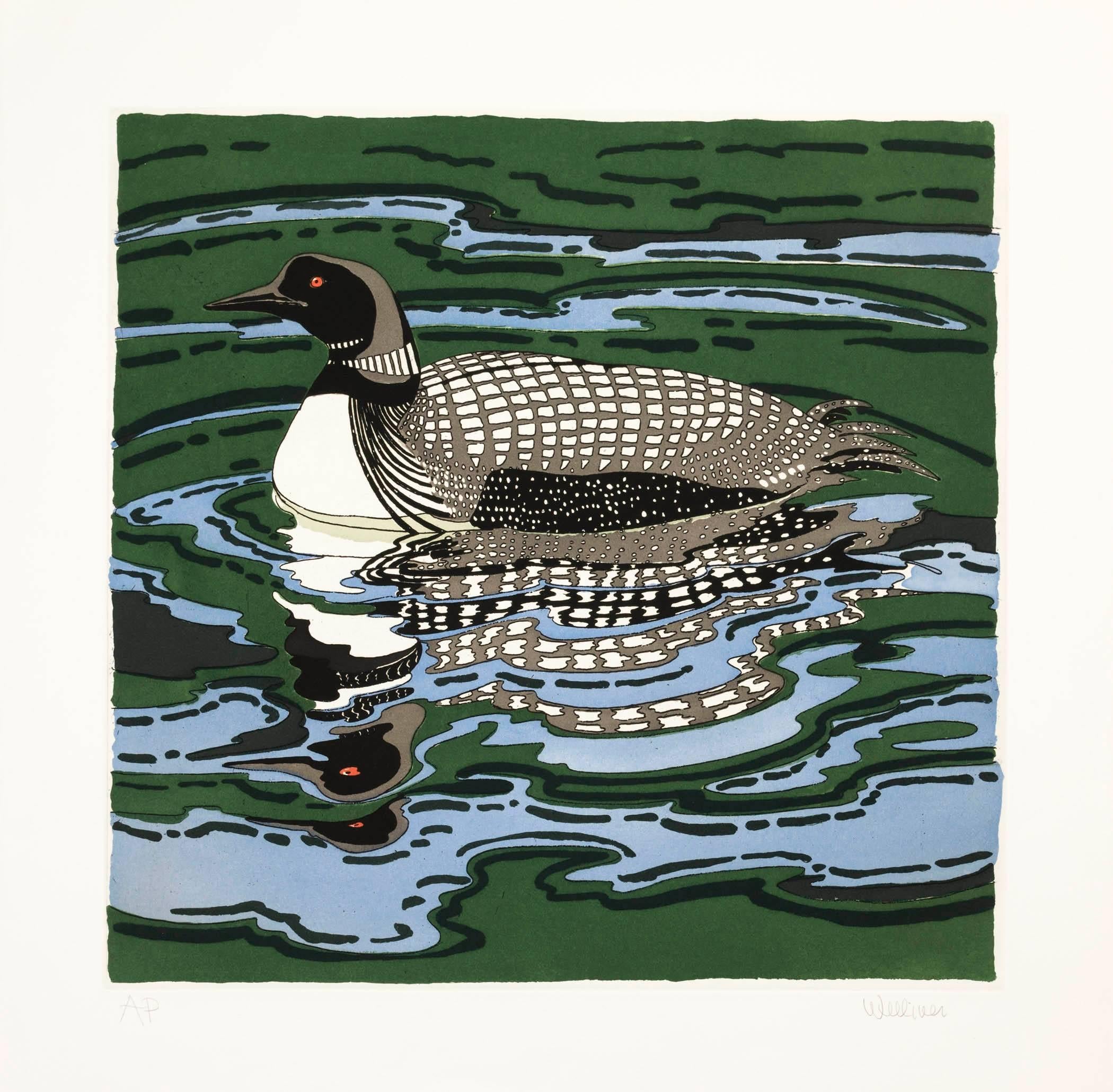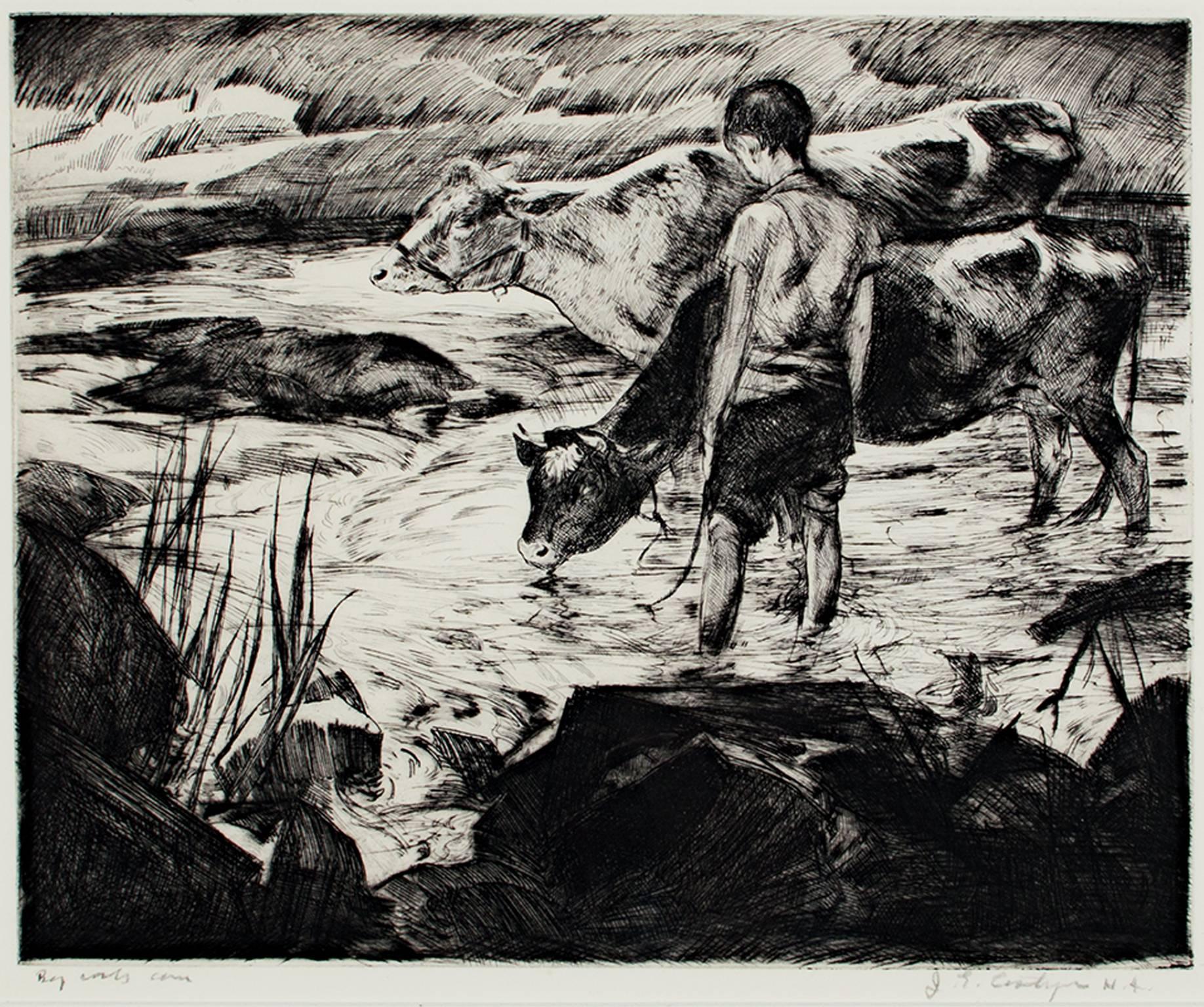Items Similar to Blue Wing
Want more images or videos?
Request additional images or videos from the seller
1 of 6
Paul H. WinchellBlue Wing c. 1940
c. 1940
About the Item
Blue Wing
Etching, c. 1940
Signed in the lower right (see photo)
Created while the artist was a commercial artist working in Minneapolis, after his tenure of being an instructor at the Minneapolis Institute of Art in the 1930's.
Provenance: estate of the artist
Winchell Heirs
Condition: Excellent
Image/Plate size: 4 3/8 x 4 15/16 inches
Paul H. Winchell (1903 – 1971) was a printmaker, illustrator, teacher, and gilder according to Crump, 2009 (Minnesota Prints and Printmakers, 1900- 1945, Minnesota Historical Society Press). He was the son of Mrs. Looman Winchell of Shepherd Rd as noted in a 1937 newspaper article (Painsville, O. Telegraph). Winchell grew up in North Perry, Ohio and then studied and worked as an instructor at the Art Institute of Chicago. He studied with Leon Kroll (1884 – 1974), Boris Anisfeld (1878-1973), Daniel Garber (1880 – 1958), Charles Woodbury (1864 – 1940), George Oberteuffer, (1878 – 1940) and Elmer A. Forsberg (1883 – 1950), although it was not stated whether each of these teachers was in Chicago or elsewhere. According to the Minneapolis School of Art Faculty Summer 1930 brochure he was an instructor at the Art Institute of Chicago for three years. According to the 1940 – 1941 catalogue, which provided a short biography and a photograph of the artist, he traveled and studied in Spain, Africa, Italy, England, Germany, and France. According to Crump, Winchell did not receive support from either the Public Works of Art Project or the Minnesota WPA Federal Art Project.
In Minneapolis, where he was an instructor at the Minneapolis School of Art, he first appeared in 1930 in the Minneapolis Institute of Arts’ Sixteenth Annual Exhibition of the Work of Minneapolis and St. Paul Artists, where he exhibited three oil paintings. He received second honorable mention in oil painting for #69 Old Family. In 1931 he received third honorable mention in oil painting for #64, his Portrait of Miss C. Winchell exhibited his work subsequently in other Minneapolis Institute of Arts (MIA) exhibitions in 1933 and 1935 – 1938. According to Crump he also received first prize in the prints category at the Minnesota State Fair in 1940. Other exhibitions included the St. Paul Gallery and School of Art, the Midwestern Artists Association, and the Kansas City Art Institute. His bio at the Minneapolis School of Art also noted he exhibited at the Chicago Art Institute. According to Crump’s summary, based on information from Who Was Who in American Art, 1564-1975 (by Peter Falk), Winchell’s knowledge of gilding as a craft for framing may have provided income supplemental to his teaching.
At the Minneapolis School of Art Winchell taught figure sketching, figure study, elementary illustration, and drawing. His Figure Sketching class in the summer of 1930 is described as follows:
“Rapid sketching from the nude develops a clearness of vision, a quick grasp of essential facts, and a sureness of expression. This class affords an opportunity for study of the figure in action poses which vary in length from one minute to fifty minutes. By making dozens of studies in pencil, crayon, and brush, the student quickly learns to make spirited, rhythmic drawings, based upon a clear understanding. In this class some drawing is done from cast in support o the other work, but the method of approach is the same, and preserves a spontaneity in the results.“
Winchell’s Elementary Illustration course description from the same catalogue states:
“This class work consists of simple illustration problems which require the representation of various objects, such as furniture, simple room interiors, buildings, sometimes in combination with the costumed figure. The theory and practice of perspective and the employment of many decorative treatments in pencil, wash, opaques, and ink, make this a very practical course for those who desire instruction in the elements of drawing as applied to a great variety of subjects. The class work takes the student to the museum galleries and occasionally out of doors for research in connection with the problems assigned.“
The above two course descriptions provide insight into the varied mediums explored by Winchell as well as his emphasis on rapid sketching and the importance of perspective.
According to the Hennepin History Museum (September 22, 2011), Winchell lived at 2416 Dupont Ave So. in 1932 and 4 West 26th St. from 1936 – 1956. In 1946, according to the same source, he was hired as an artist for Brown & Bigelow in St. Paul who typically hired local artists to illustrate calendars with representational art such as hunting scenes. Contacts with Brown & Bigelow were never returned, and a local photographer said that they were not helpful for a different project concerning earlier artistic endeavors at the company. Crump notes that in 1948 Winchell worked at the Cedar Advertising Agency in St. Paul.
- Creator:Paul H. Winchell (1903 - 1972, American)
- Creation Year:c. 1940
- Dimensions:Height: 4.38 in (11.13 cm)Width: 4.94 in (12.55 cm)
- Medium:
- Movement & Style:
- Period:
- Condition:
- Gallery Location:Fairlawn, OH
- Reference Number:
About the Seller
5.0
Recognized Seller
These prestigious sellers are industry leaders and represent the highest echelon for item quality and design.
Platinum Seller
These expertly vetted sellers are 1stDibs' most experienced sellers and are rated highest by our customers.
Established in 1978
1stDibs seller since 2013
711 sales on 1stDibs
Typical response time: 1 hour
Associations
International Fine Print Dealers Association
- ShippingRetrieving quote...Ships From: Akron, OH
- Return PolicyA return for this item may be initiated within 10 days of delivery.
More From This SellerView All
- Through Wind and Water (Notre Dame Gargoyle)By John Taylor ArmsLocated in Fairlawn, OHSigned in pencil Edition: 75 Gargoyle Series No. 7 This impression probably printed by David Strang, 1937-38 Sheet: 9 1/4 x 11 1/4" Reference: William Dolan Fletcher, John Tay...Category
1920s American Realist Still-life Prints
MaterialsEtching
- Black Ducks (Marsh Ducks)Located in Fairlawn, OHBlack Ducks (Marsh Ducks) Etching, 1964 Signed in pencil lower right Titled in pencil lower left Edition: 250 Published by Associated American Artist, New York Illustrated: AAA catal...Category
1960s American Realist Animal Prints
MaterialsEtching
- Early SpeedBy Clarence W. AndersonLocated in Fairlawn, OHEarly Speed Lithograph, 1953 Signed lower right Edition 250 Published by Associated American Artists Illustrated: AAA catalog 1953-03 Reference: AAA Index 1187 Condition: The sheet i...Category
1950s American Realist Animal Prints
MaterialsLithograph
- Action PlusBy Clarence W. AndersonLocated in Fairlawn, OHAction Plus Lithograph, 1950 Signed lower right (see photo) Titled lower left (see photo) Edition 250 Published by Associated American Artists, New York Illustrated: AAA catalogs 1950-01 and 1950-02 Reference: AAA Index No. 1072 Condition: Excellent Slight aging to paper Image size: 9 1/4 x 14 1/2 inches Sheet size: 12 x 15 7/8 inches Clarence William Anderson Clarence William Anderson (1891–1971), born in Wahoo, Nebraska, and known professionally as C.W. Anderson, was a writer and illustrator of children's books. Anderson had an interest in horses and drawing. When he wasn't out riding horses, he was drawing them, taking great interest in their bone structure and conformation. Anderson started his career by illustrating for other authors, but eventually began developing texts to accompany his realistic and lively black and white drawings. He is best known for his "Billy and Blaze" book series. The adventures of Billy and Blaze revolve around proper care of the horse, while teaching a lesson. Anderson would go to great lengths to give accurate information. He would even go on to write Heads Up, Heels Down as a training tool for young horse lovers. All of the stories Anderson wrote would be based on true stories or people that he knew-only the plots were fictitious. By the end of Anderson's life, he had written and illustrated over thirty-five horse books, and had also created covers for the Saturday Evening Post. Anderson is the namesake for Andy's Summer Playhouse, a youth theater in Wilton, New Hampshire.[1] Anderson also was a member of the Society of American Graphic Artists. Artwork portfolios • All Thoroughbreds, Harper and Brothers Publishers, 1948 – 20 illustrations • Post Parade, Harper and Brothers Publishers, 1949 – 15 illustrations • Turf and Bluegrass, Harper and Brothers Publishers, 1950 and 1952 – 15 illustrations • Grey, Bay, and Chestnut, Harper and Brothers Publishers 1952 and 1955 – 10 illustrations • Colts and Champions, Harper and Brothers Publishers, 1955 and 1956 – 10 illustrations • Accent on Youth, 1958 – 10 illustrations • Bred to Run, 1960 – 12 illustrations • The Look of a Thoroughbred, 1963 – 8 illustrations • Before the Bugle, 1965 - 9 illustrations • The World of Horses, 1965 – 8 illustrations • Fillies and Colts, year unknown – 5 illustrations • Man O'War, Horse of the Century, 1970 – 8 illustrations Works As author and illustrator • And So to Bed...Category
1950s American Realist Animal Prints
MaterialsLithograph
- Before Day LightBy Paul H. WinchellLocated in Fairlawn, OHBefore Day Light Drypoint, c. 1940 Signed lower right (see photo) Titled lower left (see photo) Created while the artist was a commercial artist working in Minneapolis. In the 1930’s...Category
1940s American Realist Animal Prints
MaterialsDrypoint
- untitled (Duck taking to flight, flushed by a dog)By Paul H. WinchellLocated in Fairlawn, OHuntitled (Duck taking to flight, flushed by a dog) Drypoint & Aquatint, c. 1940 signed lower right Created while the artist was a commercial artist working in Minneapolis, after his ...Category
1940s American Realist Animal Prints
MaterialsDrypoint
You May Also Like
- A Burro Train, New MexicoBy Peter MoranLocated in Middletown, NYEtching with aquatint on heavy laid paper, 7 x 9 1/4 inches (172 x 233 mm), full margins. Signed in the plate, lower right image area. Minor corner loss, top right, and a 1/4 inch ed...Category
Late 19th Century American Realist Animal Prints
MaterialsLaid Paper, Etching
- LoonBy Neil WelliverLocated in New York, NYNeil Welliver Loon, 1998 color etching, ed. of 175 29 3/4 x 29 5/8 in. (75.6 x 75.2 cm)Category
1990s American Realist Animal Prints
MaterialsEtching
- "Boy With Cows, " Original Drypoint Etching signed by John Edward CostiganBy John Edward CostiganLocated in Milwaukee, WI"Boy With Cows" is an original drypoint etching by John Edward Costigan. It depicts a young boy with three cows standing in a watering hole. The artist si...Category
1930s American Realist Figurative Prints
MaterialsDrypoint, Etching
- Pike IIIBy Robert A. BirmelinLocated in Surfside, FLA fine etching of a Pike Fish. Perfect for the angler or sport fisherman Born in Newark, New Jersey, Robert Birmelin became a professor of fine arts at Queens College in New York, an...Category
20th Century American Realist Animal Prints
MaterialsEtching
- A Burro Train, New MexicoBy Peter MoranLocated in San Francisco, CAThis artwork titled "A Burro Train, New Mexico" 1880 is an original etching on Laid paper by noted British/American artist Peter Moran, 1841-1914. It is signed in the plate as issue. The plate mark (Image) size is 9.15 x 6.5 inches, framed size is 14.75 x 18.75 inches. It is framed in a wooden silver frame, with light grey matting. It is in excellent condition, especially considering the age. I like to mention that example of this particular etching is held in the following museums, including, The Toledo Museum Of Art, Toledo, The British Museum, London and The Smithsonian Museum Of Art, Washington D.C. It was also illustrated in American Art Review, volume #2 1881, page 163. About the artist: The younger brother of Thomas Moran, Peter Moran was a painter-etcher best known for his Romantic sensibility and landscape compositions incorporating animals. The Moran family immigrated to the United States from England in 1844, when Peter was three. He began his artistic career as an apprentice to a lithographic firm and eventually studied painting with his brothers Edward and Thomas. He was influenced by the animal paintings of Rosa Bonheur and Constant Troyon and visited England in 1863 to see those of Edwin Landseer. Moran took up etching in 1874, using that medium to record genre scenes that he observed while traveling in New Mexico and Arizona in 1881 on an ethnographic expedition to study Pueblo Indian culture. He later returned to the Southwest in 1890 as an artist for the Bureau of Indian Affairs. In 1882, Moran joined Henry R. Poore, an artist friend, on a visit to Taos Pueblo where the two were given a room and spent a week watching the activities associated with the harvest. Poore recounted the details of their travels in an article titled "A Harvest with the Taos Indians...Category
Late 19th Century American Realist Animal Prints
MaterialsEtching
- Drawn from the Heart ( 1, 2&3 )By Bev DoolittleLocated in Austin, TX"Drawn from the Heart" by Bev Doolittle Set of Three Signed Limited Edition Original Etching on PaperCategory
1990s American Realist Animal Prints
MaterialsEtching
Recently Viewed
View AllMore Ways To Browse
On The Wing
Vintage Blue Photos
A Wing Vintage
France Blue Nevers
September Blue
St Pauls Vintage
St Paul Vintage
Blue Wing
Vintage Family Illustration
Blue Vintage Door
Blue Door Vintage
Winged Figure
French Blue Door
Charles H Wells
Costume Institute
Old Blue Plates
Vintage Teacher Illustration
Used Furniture St Paul




